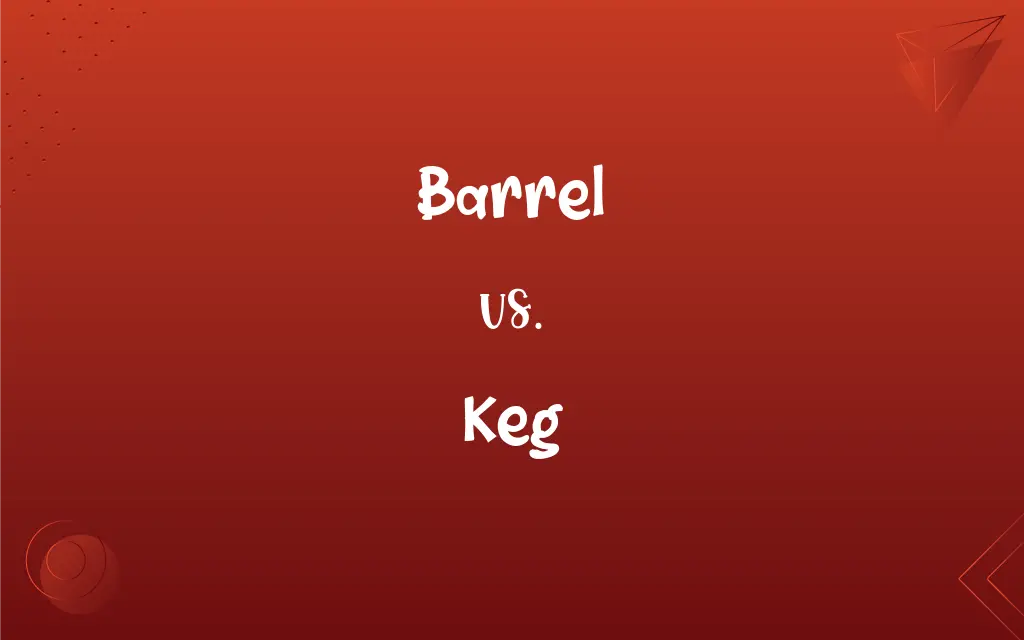Barrel vs. Keg: What's the Difference?
By Harlon Moss & Janet White || Updated on May 22, 2024
A barrel is a large cylindrical container used for storing and transporting liquids or solids, while a keg is a smaller, often pressurized container specifically used for storing and dispensing beverages, particularly beer.

Key Differences
A barrel is a large, typically wooden container with a cylindrical shape, used for storing and transporting a variety of liquids and solids, including wine, oil, and dry goods. Barrels have been traditionally made from wood staves and are sealed with hoops. A keg, on the other hand, is a smaller container, usually made of metal or plastic, designed primarily for storing and dispensing beverages, especially beer. Kegs are often pressurized to keep the contents carbonated and fresh, and they come in standardized sizes like the half-barrel (15.5 gallons) or the quarter-barrel (7.75 gallons).
Barrels are often used in the aging process for beverages like wine and whiskey, where the wood can impart flavors and characteristics to the liquid. Kegs are primarily used for distribution and serving, particularly in commercial settings such as bars and restaurants, where they can be tapped to dispense the beverage directly.
In terms of usage, barrels have a broad application for various industries, including food, chemicals, and oil. Kegs are specifically tailored for the beverage industry, providing a convenient way to transport and serve carbonated drinks.
Barrels have a traditional, rustic appearance and are often associated with artisanal and aged products. Kegs, however, are more functional and industrial in design, focusing on preserving the quality and carbonation of the beverages they contain.
Comparison Chart
Primary Use
Storing and transporting liquids/solids
Storing and dispensing beverages
ADVERTISEMENT
Material
Typically wood, sometimes metal/plastic
Mostly metal or plastic
Size
Larger (commonly 55 gallons)
Smaller (common sizes: 15.5, 7.75 gallons)
Construction
Made from staves and sealed with hoops
Often pressurized with a valve system
Application
Broad (food, chemicals, oil)
Specific to beverage industry
Barrel and Keg Definitions
Barrel
A large cylindrical container made of wood, metal, or plastic.
The winery aged its best wine in oak barrels.
ADVERTISEMENT
Keg
A container used to dispense pressurized drinks.
They tapped the keg for the party.
Barrel
A cylindrical part of a firearm through which the bullet travels.
The rifle's barrel was polished to perfection.
Keg
A unit of measure for beer, often a quarter or half barrel.
They ordered a half-barrel keg for the event.
Barrel
To move at high speed in an uncontrolled manner.
The car barreled down the highway.
Keg
A small barrel, typically for beer or other beverages.
The pub served beer from a stainless steel keg.
Barrel
The main part of a drum.
The sound resonated from the barrel of the drum.
Keg
A cylindrical container that can be pressurized.
The soda was stored in a pressurized keg.
Barrel
A large cylindrical container, usually made of staves bound together with hoops, with a flat top and bottom of equal diameter.
Keg
To store or serve beverages from a keg.
The brewery kegs their seasonal beers.
Barrel
The quantity that a barrel with a given or standard capacity will hold.
Keg
A small cask or barrel with a capacity of about 30 gallons (114 liters).
Barrel
Abbr. bar. or bbl. or bl. Any of various units of volume or capacity. In the US Customary System it varies, as a liquid measure, from 31 to 42 gallons (117 to 159 liters) as established by law or usage.
Keg
Such a container and its contents.
Barrel
The thicker portion of a baseball bat, from which the most powerful hits are struck.
Keg
A unit of weight used for nails, equal to 100 pounds (45.5 kilograms).
Barrel
The cylindrical part of a firearm through which the bullet travels.
Keg
To put or store in a small cask or barrel.
Barrel
A cylinder that contains a movable piston.
Keg
A round, traditionally wooden container of lesser capacity than a barrel, often used to store beer.
Barrel
The drum of a capstan.
Keg
(transitive) To store in a keg.
Barrel
The cylinder within the mechanism of a timepiece that contains the mainspring.
Keg
A small cask or barrel.
Barrel
The trunk of a quadruped animal, such as a horse or cow.
Keg
The quantity contained in a keg
Barrel
The tubular space inside a wave when it is breaking.
Keg
Small cask or barrel
Barrel
(Informal) A large quantity
A barrel of fun.
Barrel
(Slang) An act or instance of moving rapidly, often recklessly, in a motor vehicle.
Barrel
Resembling or similar to a barrel, as in shape
A barrel chest.
Barrel hips.
Barrel
To put or pack in a barrel.
Barrel
To move or progress rapidly
"That the European Union barreled ahead was not surprising" (Richard W. Stevenson).
Barrel
(countable) A round (cylindrical) vessel, such as a cask, of greater length than breadth, and bulging in the middle, made of staves bound with hoops, and having flat ends (head). Sometimes applied to a similar cylindrical container made of metal, usually called a drum.
A cracker barrel
Barrel
Such a cask of a certain size, holding one-eighth of what a tun#Noun holds. (See a diagram comparing cask sizes.)
Barrel
The quantity which constitutes a full barrel: the volume or weight this represents varies by local law and custom.
Barrel
A solid drum, or a hollow cylinder or case
The barrel of a windlass;
The barrel of a watch, within which the spring is coiled.
Barrel
A metallic tube, as of a gun, from which a projectile is discharged.
Barrel
(television) A ceiling-mounted tube from which lights are suspended.
Barrel
(archaic) A tube.
Barrel
(zoology) The hollow basal part of a feather.
Barrel
(music) The part of a clarinet which connects the mouthpiece and upper joint, and looks rather like a barrel (1).
Barrel
(surfing) A wave that breaks with a hollow compartment.
Barrel
A waste receptacle.
Throw it into the trash barrel.
Barrel
The ribs and belly of a horse or pony.
Barrel
(obsolete) A jar.
Barrel
(biology) Any of the dark-staining regions in the somatosensory cortex of rodents, etc., where somatosensory inputs from the contralateral side of the body come in from the thalamus.
Barrel
(baseball) A statistic derived from launch angle and exit velocity of a ball hit in play.
Barrel
(transitive) To put or to pack in a barrel or barrels.
Barrel
(intransitive) To move quickly or in an uncontrolled manner.
He came barrelling around the corner and I almost hit him.
Barrel
(intransitive) To assume the shape of a barrel; specifically, of the image on a computer display, television, etc., to exhibit barrel distortion, where the sides bulge outwards.
Barrel
A round vessel or cask, of greater length than breadth, and bulging in the middle, made of staves bound with hoops, and having flat ends or heads; as, a cracker barrel. Sometimes applied to a similar cylindrical container made of metal, usually called a drum.
Barrel
The quantity which constitutes a full barrel. This varies for different articles and also in different places for the same article, being regulated by custom or by law. A barrel of wine is 31½ gallons; a barrel of flour is 196 pounds.
Barrel
A solid drum, or a hollow cylinder or case; as, the barrel of a windlass; the barrel of a watch, within which the spring is coiled.
Barrel
A metallic tube, as of a gun, from which a projectile is discharged.
Barrel
A jar.
Barrel
The hollow basal part of a feather.
Barrel
To put or to pack in a barrel or barrels.
Barrel
A tube through which a bullet travels when a gun is fired
Barrel
A cylindrical container that holds liquids
Barrel
A bulging cylindrical shape; hollow with flat ends
Barrel
The quantity that a barrel (of any size) will hold
Barrel
Any of various units of capacity;
A barrel of beer is 31 gallons and a barrel of oil is 42 gallons
Barrel
Put in barrels
Barrel
A unit of measurement for liquid capacity.
The oil was measured in barrels.
FAQs
How are barrels constructed?
Barrels are traditionally made from wooden staves and sealed with metal hoops.
How do kegs maintain carbonation?
Kegs are often pressurized, which helps maintain the carbonation of the beverages.
What is a barrel?
A barrel is a large cylindrical container used for storing and transporting liquids or solids.
What is a keg?
A keg is a smaller, often pressurized container used for storing and dispensing beverages, particularly beer.
What is the typical size of a barrel?
Barrels vary in size, with a common modern size being 55 gallons.
What materials are kegs made from?
Kegs are usually made from metal or plastic.
What are the common sizes of kegs?
Common keg sizes include the half-barrel (15.5 gallons) and quarter-barrel (7.75 gallons).
Can barrels be used for aging beverages?
Yes, barrels are often used to age beverages like wine and whiskey, imparting unique flavors.
Are kegs used for storing non-beverage items?
Kegs are primarily designed for beverages, particularly those that need to be carbonated.
How is beer dispensed from a keg?
Beer is dispensed from a keg using a tap system, often involving a pressurized valve.
What role do barrels play in flavoring beverages?
Barrels can impart flavors to beverages during the aging process, especially if made of wood.
How are barrels sealed?
Barrels are sealed using metal hoops that hold the staves together tightly.
What is the difference in appearance between barrels and kegs?
Barrels have a traditional, rustic look, while kegs are more functional and industrial.
Are kegs recyclable?
Many kegs, especially those made of metal, are recyclable.
Do barrels have specific regulations for food storage?
Yes, barrels used for food and beverages often need to meet specific regulatory standards.
Can kegs be used for non-carbonated beverages?
Yes, kegs can be used for non-carbonated beverages, although they are most commonly associated with carbonated drinks like beer.
Where are kegs typically used?
Kegs are commonly used in the beverage industry, especially in bars and restaurants.
Where are barrels commonly used?
Barrels are used in various industries, including food, chemicals, and oil.
Can barrels be reused?
Yes, barrels can be reused, especially in industries like winemaking and whiskey production.
Are kegs suitable for home use?
Yes, smaller kegs can be used for home brewing and dispensing.
About Author
Written by
Harlon MossHarlon is a seasoned quality moderator and accomplished content writer for Difference Wiki. An alumnus of the prestigious University of California, he earned his degree in Computer Science. Leveraging his academic background, Harlon brings a meticulous and informed perspective to his work, ensuring content accuracy and excellence.
Co-written by
Janet WhiteJanet White has been an esteemed writer and blogger for Difference Wiki. Holding a Master's degree in Science and Medical Journalism from the prestigious Boston University, she has consistently demonstrated her expertise and passion for her field. When she's not immersed in her work, Janet relishes her time exercising, delving into a good book, and cherishing moments with friends and family.































































